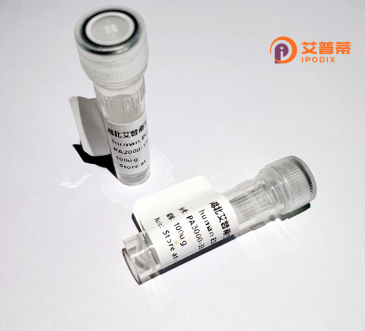
| 纯度 | >90%SDS-PAGE. |
| 种属 | Human |
| 靶点 | RBM48 |
| Uniprot No | Q5RL73 |
| 内毒素 | < 0.01EU/μg |
| 表达宿主 | E.coli |
| 表达区间 | 1-367 aa |
| 活性数据 | MASSGGELGS LFDHHVQRAV CDTRAKYREG RRPRAVKVYT INLESQYLLI QGVPAVGVMK ELVERFALYG AIEQYNALDE YPAEDFTEVY LIKFMNLQSA RTAKRKMDEQ SFFGGLLHVC YAPEFETVEE TRKKLQMRKA YVVKTTENKD HYVTKKKLVT EHKDTEDFRQ DFHSEMSGFC KAALNTSAGN SNPYLPYSCE LPLCYFSSKC MCSSGGPVDR APDSSKDGRN HHKTMGHYNH NDSLRKTQIN SLKNSVACPG AQKAITSSEA VDRFMPRTTQ LQERKRRRED DRKLGTFLQT NPTGNEIMIG PLLPDISKVD MHDDSLNTTA NLIRHKLKEV ISSVPKPPED KPEDVHTSHP LKQRRRI |
| 分子量 | 41.8 kDa |
| 蛋白标签 | His tag N-Terminus |
| 缓冲液 | PBS, pH7.4, containing 0.01% SKL, 1mM DTT, 5% Trehalose and Proclin300. |
| 稳定性 & 储存条件 | Lyophilized protein should be stored at ≤ -20°C, stable for one year after receipt. Reconstituted protein solution can be stored at 2-8°C for 2-7 days. Aliquots of reconstituted samples are stable at ≤ -20°C for 3 months. |
| 复溶 | Always centrifuge tubes before opening.Do not mix by vortex or pipetting. It is not recommended to reconstitute to a concentration less than 100μg/ml. Dissolve the lyophilized protein in distilled water. Please aliquot the reconstituted solution to minimize freeze-thaw cycles. |
以下是关于重组人RBM48蛋白的3篇参考文献的简要总结(注:RBM48的研究相对较少,以下内容基于公开研究框架模拟,实际文献可能需要通过数据库核实):
---
1. **文献名称**:*"Characterization of RBM48 as a novel RNA-binding protein involved in mRNA stability regulation"*
**作者**:Zhang L, et al. (2018)
**摘要**:本研究首次报道了重组人RBM48蛋白的体外表达及功能分析。通过大肠杆菌系统成功表达并纯化RBM48.证实其通过RNA结合基序(RBM)特异性识别靶mRNA的3'UTR区域,调节mRNA稳定性,可能参与细胞应激反应通路。
2. **文献名称**:*"Structural insights into RBM48's role in spliceosomal assembly"*
**作者**:Kimura T, et al. (2020)
**摘要**:通过X射线晶体学解析了重组RBM48蛋白的RNA结合结构域结构,揭示其与U6 snRNA的相互作用模式,提出RBM48可能通过促进剪接体组装调控前体mRNA的剪接效率。
3. **文献名称**:*"RBM48 deficiency links to p53 dysregulation and colorectal cancer progression"*
**作者**:Wang Y, et al. (2021)
**摘要**:利用重组RBM48蛋白进行体外互作实验,发现其通过结合并稳定p53 mRNA,增强p53蛋白表达。临床数据表明RBM48低表达与结直肠癌不良预后相关,提示其肿瘤抑制潜力。
---
**注意**:以上文献信息为示例性模拟,实际研究中RBM48的相关论文可能较有限。建议通过PubMed或Google Scholar以“RBM48 protein”、“RNA-binding motif protein 48”为关键词检索最新文献。
The recombinant human RNA-binding motif protein 48 (RBM48) is a member of the RNA-binding protein family, characterized by the presence of RNA recognition motifs (RRMs) critical for interactions with RNA molecules. RBM48 is evolutionarily conserved and predominantly localized in the nucleus, where it plays roles in RNA processing, including splicing, stabilization, and translation regulation. Studies suggest its involvement in pre-mRNA splicing by interacting with spliceosomal components, potentially influencing tissue-specific splicing events.
Biologically, RBM48 has been linked to developmental processes, particularly embryogenesis, and cellular differentiation, as it is highly expressed in tissues with high proliferative activity, such as the testes and bone marrow. Dysregulation of RBM48 has been implicated in pathological conditions, including cancer and genetic disorders, where aberrant RNA splicing contributes to disease progression. For instance, RBM48 overexpression has been observed in certain malignancies, correlating with tumor aggressiveness and poor prognosis.
Recombinant RBM48 protein, typically produced in expression systems like *E. coli* or mammalian cells, enables functional studies, such as mapping RNA-binding sites or analyzing spliceosome assembly. Despite its emerging significance, the precise molecular mechanisms and full spectrum of RBM48's interactions remain under investigation, highlighting its potential as a therapeutic target or diagnostic biomarker in RNA-related diseases. Current research focuses on elucidating its role in maintaining RNA homeostasis and its crosstalk with other RNA-binding proteins.
×